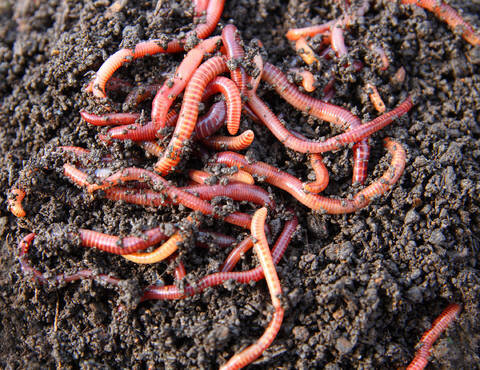Healthy red worms: For organic farming
Healthy red worms: For organic farming
Blog Article
The Ultimate Overview to Red Wigglers for Healthy Soil
The duty of red wigglers, clinically understood as Eisenia fetida, in soil wellness is a topic of enhancing rate of interest among sustainable gardening lovers and farming specialists alike. These microorganisms not only recycle organic waste yet likewise boost dirt fertility via their nutrient-rich spreadings.
What Are Red Wigglers?
Red wigglers, medically called Eisenia fetida, play a crucial duty in composting and soil health. These earthworms are particularly fit for vermicomposting, a process that uses their all-natural behaviors to decay raw material effectively. Unlike various other earthworm species, red wigglers thrive in rich organic atmospheres, making them excellent for compost bins and worm ranches.
Gauging concerning three to 4 inches in length, red wigglers have a distinctive reddish-brown coloration and a fractional body that helps in their flexibility through rotting materials. They are detritivores, indicating they prey on decomposing natural compounds, including kitchen scraps, plant debris, and paper items. red worms. Through their usage of these materials, they help damage down complex substances, transforming them right into nutrient-rich spreadings that improve dirt high quality
Red wigglers are additionally prolific breeders, qualified of duplicating promptly under ideal problems. Their versatility to different environments enables them to grow in a range of composting systems. By understanding the biology and ecological significance of red wigglers, gardeners and farmers can harness their abilities to improve dirt health and advertise sustainable methods in agriculture.

Benefits of Red Wigglers
The countless benefits of incorporating red wigglers right into composting techniques dramatically enhance soil wellness and fertility. These earthworms, scientifically called Eisenia fetida, excel at breaking down raw material, transforming kitchen scraps and backyard waste into nutrient-rich vermicompost. This procedure not just increases decomposition yet additionally improves the soil with important nutrients such as nitrogen, phosphorus, and potassium.
Furthermore, red wigglers improve soil structure by producing aggregates that help with aeration and water retention. Their burrowing tasks promote a well-aerated setting, enabling origins to gain access to oxygen more successfully. This improved aeration likewise fosters advantageous microbial task, which is vital for vitamins and mineral cycling and total soil vitality.
Along with boosting dirt composition and framework, red wigglers add to pest management. Their visibility in the dirt assists suppress damaging nematodes and other bugs, reducing the need for chemical treatments. Furthermore, the application of vermicompost leads to increased plant strength against conditions, advertising healthier growth.
Setting Up a Worm Container
Establishing up a worm bin can be a rewarding undertaking for those wanting to enhance their composting efforts. The initial step is choosing an ideal container, ideally constructed from plastic or wood, with an ability of at the very least 10 gallons to suit the worms and their food. Make sure the bin has appropriate air flow-- pierce little openings in the lid and sides to promote air flow while protecting against excess dampness build-up.

Introduce the red wigglers into the container, permitting them to accustom to their new setting. Ideally, start with a populace of concerning one pound of worms per square foot of surface. Ultimately, position the worm bin in an area that maintains a secure temperature level, preferably between 55 ° F and 77 ° F. With these foundational actions, your worm container will prepare to grow in the quest of healthy and balanced soil.
(eisenia fetida worms for sale)
Feeding Your Red Wigglers
When it involves nurturing red wigglers, comprehending their nutritional requirements is crucial for maintaining a healthy and balanced worm container. These worms thrive on a varied diet plan, largely made up of organic issue. Suitable food sources include fruit and veggie scraps, coffee grounds, smashed eggshells, and shredded paper or cardboard. It is essential to prevent feeding them citrus fruits, onions, and garlic, as these can be detrimental to their wellness.
Section control is essential; overfeeding can bring about smell problems and draw in insects. A great general rule is to supply food that is about equivalent to the weight of the worms in the bin every week. Display the consumption rate and change feeding quantities as necessary.
To promote a balanced diet, purpose to provide a mix of nitrogen-rich eco-friendlies, such as veggie peels, and carbon-rich browns, such as dried out leaves or cardboard. Furthermore, maintaining appropriate moisture levels is necessary-- food scraps ought to perspire yet not soaked - red worms. By meticulously handling their diet and setting, you will certainly guarantee that your red wigglers remain healthy and balanced and productive, contributing efficiently to the composting procedure
Using Worm Castings in Dirt
Incorporating worm castings into dirt can dramatically enhance its wellness and fertility. Worm spreadings, also referred to as vermicompost, are a rich source of nutrients, including nitrogen, phosphorus, and potassium, important for plant development. When included to soil, these castings enhance its framework by increasing aeration and improving dampness retention, which is particularly valuable in dry areas.
Additionally, worm spreadings my review here introduce valuable bacteria that advertise a healthy and balanced soil ecosystem (red worms). These bacteria aid in damaging down natural matter, making nutrients quicker available to plants. The visibility of these microorganisms likewise assists subdue soil-borne diseases, minimizing the requirement for chemical plant foods and pesticides
To use worm castings efficiently, mix them into the top couple of inches of dirt before planting or apply them as a leading clothing around established plants. A suggested application rate has to do with 10-20% spreadings combined with dirt to enhance nutrient availability without overwhelming the plants.
Conclusion
In verdict, red wigglers, or Eisenia fetida, play a crucial role in improving dirt wellness via their vermicomposting tasks. Ultimately, the assimilation of red wigglers right into soil monitoring methods promotes sustainable agriculture by lowering dependence on chemical plant foods and fostering helpful microbial activity.
Report this page